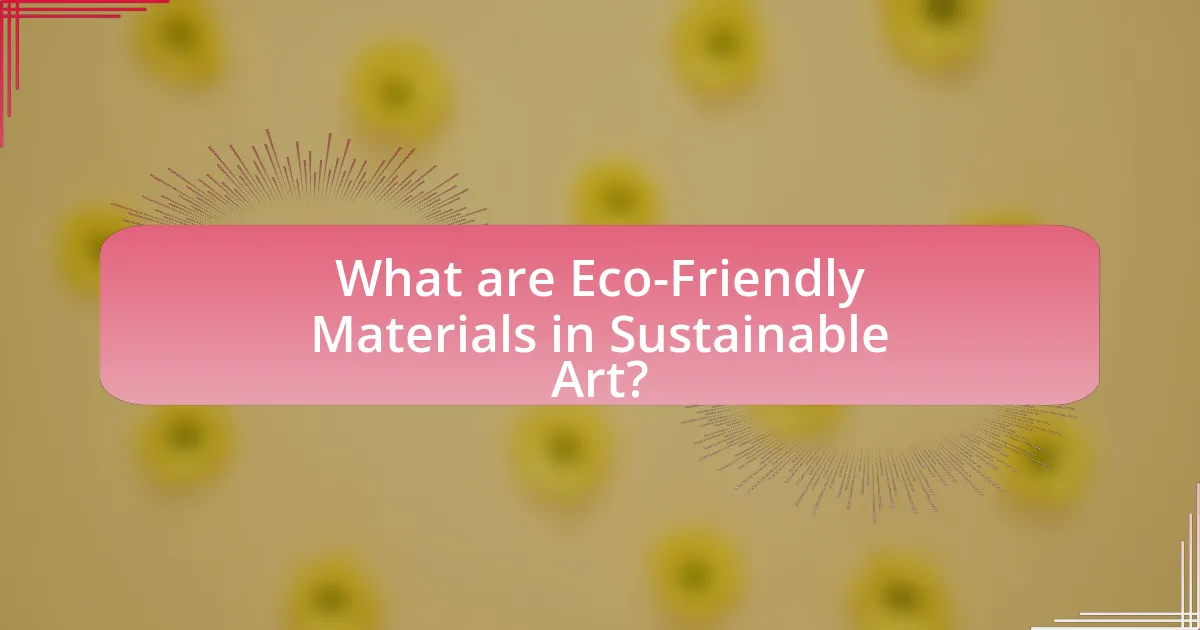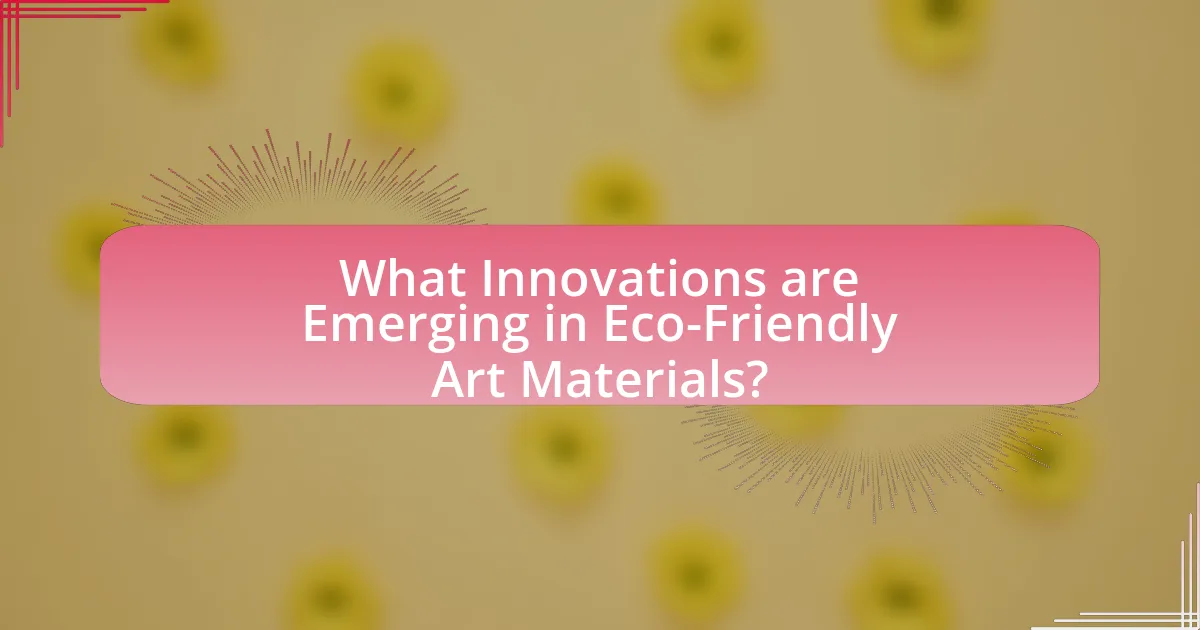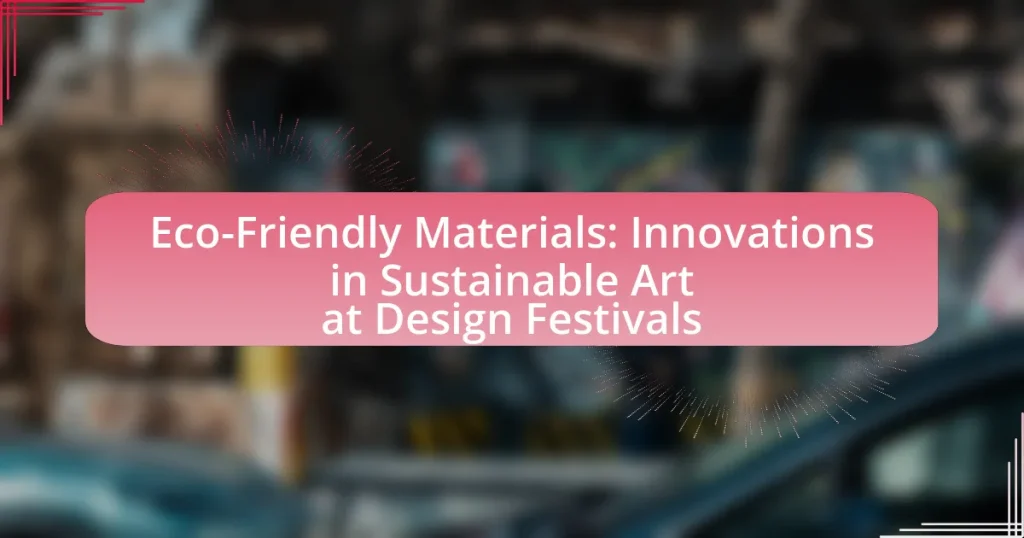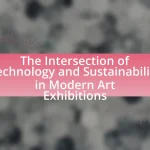Eco-friendly materials play a crucial role in sustainable art by minimizing environmental impact and promoting resource conservation. This article explores various eco-friendly materials commonly used in art, such as recycled paper, organic cotton, bamboo, and non-toxic paints, highlighting their benefits in reducing waste and pollution. It also discusses the innovations emerging in sustainable art materials, the influence of design festivals in promoting eco-friendly practices, and the challenges artists face when incorporating these materials into their work. Additionally, the article outlines best practices for sourcing and utilizing eco-friendly materials, emphasizing their significance in fostering a culture of sustainability within the art community.

What are Eco-Friendly Materials in Sustainable Art?
Eco-friendly materials in sustainable art are substances that minimize environmental impact while promoting artistic expression. These materials include recycled paper, organic cotton, bamboo, reclaimed wood, and non-toxic paints, which reduce waste and pollution. For instance, using recycled paper helps divert waste from landfills, while organic cotton avoids harmful pesticides, contributing to healthier ecosystems. Additionally, bamboo is a rapidly renewable resource, making it a sustainable choice for various art forms. The adoption of these materials is supported by the growing movement towards sustainability in the art community, as evidenced by initiatives at design festivals that showcase innovative uses of eco-friendly materials.
How do Eco-Friendly Materials contribute to Sustainable Art?
Eco-friendly materials significantly contribute to sustainable art by reducing environmental impact and promoting resource conservation. These materials, such as recycled plastics, organic fabrics, and sustainably sourced wood, minimize waste and lower carbon footprints during production. For instance, using recycled materials can divert waste from landfills, with studies showing that recycling one ton of plastic can save approximately 7.4 cubic yards of landfill space. Additionally, eco-friendly materials often require less energy to produce, further decreasing greenhouse gas emissions. By incorporating these materials, artists not only create visually appealing works but also advocate for environmental responsibility, fostering a culture of sustainability within the art community.
What types of Eco-Friendly Materials are commonly used in art?
Eco-friendly materials commonly used in art include recycled paper, natural pigments, organic cotton, bamboo, and reclaimed wood. Recycled paper serves as a sustainable canvas, while natural pigments derived from plants and minerals provide non-toxic color options. Organic cotton is favored for textiles, and bamboo is utilized for its rapid growth and renewability. Reclaimed wood is often repurposed for sculptures and installations, reducing waste and promoting sustainability. These materials not only minimize environmental impact but also support the growing movement towards sustainable practices in the art community.
How do these materials impact the environment?
Eco-friendly materials significantly reduce environmental impact by minimizing waste, lowering carbon emissions, and promoting sustainability. For instance, materials such as bamboo and recycled plastics require less energy to produce compared to traditional materials, resulting in a smaller carbon footprint. Additionally, the use of biodegradable materials helps decrease landfill waste, as they break down naturally over time. Research indicates that using sustainable materials can reduce greenhouse gas emissions by up to 50% compared to conventional materials, highlighting their positive contribution to environmental conservation.
Why is the use of Eco-Friendly Materials important in art?
The use of eco-friendly materials in art is important because it reduces environmental impact and promotes sustainability. Artists who utilize these materials contribute to the conservation of natural resources and minimize pollution associated with traditional art supplies. For instance, a study published in the Journal of Cleaner Production highlights that using biodegradable materials can significantly lower carbon emissions compared to conventional materials. This shift not only fosters a healthier planet but also encourages a cultural movement towards responsible consumption and environmental awareness within the art community.
What are the environmental benefits of using Eco-Friendly Materials?
Using eco-friendly materials significantly reduces environmental impact by minimizing resource depletion and pollution. These materials are often sourced sustainably, which helps preserve ecosystems and biodiversity. For instance, biodegradable materials break down naturally, reducing landfill waste and greenhouse gas emissions. Additionally, the production of eco-friendly materials typically requires less energy and water compared to conventional materials, leading to lower carbon footprints. Research indicates that using recycled materials can save up to 95% of the energy needed to produce new products from raw materials, further demonstrating their environmental benefits.
How do Eco-Friendly Materials influence artistic expression?
Eco-friendly materials significantly influence artistic expression by enabling artists to explore themes of sustainability and environmental consciousness. These materials, such as recycled plastics, organic pigments, and biodegradable substances, allow artists to create works that reflect ecological concerns and promote awareness of environmental issues. For instance, the use of reclaimed wood in sculpture not only provides a unique aesthetic but also tells a story of resourcefulness and conservation. Additionally, artists like El Anatsui have gained recognition for their large-scale installations made from discarded materials, which challenge traditional notions of beauty and value in art. This shift towards eco-friendly materials fosters innovation in techniques and concepts, encouraging a dialogue about the relationship between art and the environment.

What Innovations are Emerging in Eco-Friendly Art Materials?
Innovations in eco-friendly art materials include the development of biodegradable paints, natural pigments derived from plants, and recycled materials for canvases and sculptures. Biodegradable paints, such as those made from soy or corn, reduce environmental impact by breaking down naturally after use. Natural pigments sourced from fruits, vegetables, and minerals provide vibrant colors without harmful chemicals, promoting safer art practices. Additionally, artists are increasingly utilizing recycled materials, such as repurposed plastics and metals, to create sustainable artworks, thereby minimizing waste and encouraging a circular economy in the art sector. These advancements reflect a growing commitment to sustainability within the art community, aligning with broader environmental goals.
How are artists incorporating new Eco-Friendly Materials into their work?
Artists are incorporating new eco-friendly materials into their work by utilizing sustainable resources such as recycled plastics, organic pigments, and biodegradable substances. For instance, many artists are now creating sculptures and installations from reclaimed materials, which not only reduces waste but also promotes environmental awareness. A notable example is the use of mycelium, a biodegradable material derived from fungi, which has gained popularity for its versatility and minimal environmental impact. Additionally, artists are increasingly experimenting with plant-based inks and natural fibers, aligning their practices with eco-conscious principles. This shift is supported by the growing trend of design festivals that showcase sustainable art, highlighting the innovative use of these materials and encouraging broader adoption within the art community.
What are some examples of innovative Eco-Friendly Materials?
Some examples of innovative eco-friendly materials include mycelium, which is derived from fungi and can be used as a biodegradable alternative to plastics, and hempcrete, a sustainable building material made from hemp fibers and lime that offers insulation and carbon sequestration properties. Additionally, recycled ocean plastics are being transformed into textiles and packaging, reducing marine waste while creating functional products. These materials are gaining traction in sustainable art and design, as they align with the growing demand for environmentally responsible practices in creative industries.
How do these innovations enhance the sustainability of art?
Innovations in eco-friendly materials enhance the sustainability of art by reducing environmental impact and promoting resource efficiency. For instance, the use of biodegradable paints and recycled materials minimizes waste and lowers carbon footprints associated with traditional art supplies. Research indicates that artists utilizing sustainable materials can significantly decrease their reliance on harmful chemicals, thereby improving air quality and reducing pollution. Additionally, these innovations encourage a circular economy within the art community, where materials are reused and repurposed, further contributing to sustainability efforts.
What role do design festivals play in promoting Eco-Friendly Art?
Design festivals play a crucial role in promoting eco-friendly art by providing a platform for artists to showcase sustainable practices and materials. These events often feature exhibitions that highlight innovative uses of recycled, biodegradable, and non-toxic materials, encouraging both artists and attendees to engage with environmentally conscious art. For instance, the London Design Festival has included installations that utilize reclaimed materials, demonstrating the potential of waste in artistic creation. Additionally, design festivals often host workshops and discussions focused on sustainability, fostering a community that prioritizes eco-friendly practices in the art world. This collective effort not only raises awareness but also inspires a shift towards more sustainable art-making processes.
How do design festivals showcase innovations in sustainable art?
Design festivals showcase innovations in sustainable art by featuring works that utilize eco-friendly materials and practices. These events often include exhibitions, installations, and workshops that highlight artists and designers who prioritize sustainability in their creative processes. For instance, festivals like the London Design Festival and Milan Design Week have dedicated sections for sustainable design, where artists present pieces made from recycled, biodegradable, or renewable materials. This focus not only raises awareness about environmental issues but also encourages collaboration among creators, manufacturers, and consumers to promote sustainable practices in the art and design community.
What impact do design festivals have on public awareness of Eco-Friendly Materials?
Design festivals significantly enhance public awareness of eco-friendly materials by showcasing innovative sustainable designs and educating attendees about their benefits. These events often feature exhibitions, workshops, and discussions that highlight the importance of using environmentally responsible materials in art and design. For instance, the London Design Festival has included installations that emphasize recycled and biodegradable materials, attracting thousands of visitors and generating media coverage that amplifies the message. Research indicates that exposure to such initiatives increases consumer interest in sustainable products, as seen in a study by the Ellen MacArthur Foundation, which found that 66% of consumers are more likely to purchase products made from sustainable materials after attending related events.

How can artists effectively utilize Eco-Friendly Materials at Design Festivals?
Artists can effectively utilize eco-friendly materials at design festivals by incorporating sustainable resources such as recycled plastics, organic fabrics, and biodegradable paints into their artworks. This approach not only reduces environmental impact but also aligns with the growing consumer demand for sustainability in art. For instance, a study by the Ellen MacArthur Foundation highlights that using recycled materials can significantly lower carbon emissions associated with production processes. Additionally, artists can engage festival attendees by showcasing the benefits of these materials through interactive installations, thereby raising awareness about sustainability in the art community.
What best practices should artists follow when using Eco-Friendly Materials?
Artists should prioritize sourcing eco-friendly materials from sustainable suppliers to minimize environmental impact. This involves selecting non-toxic paints, recycled papers, and biodegradable mediums, which reduce harmful emissions and waste. Additionally, artists should practice proper disposal methods for any waste generated during their creative process, ensuring that materials are recycled or composted when possible. Research indicates that using sustainable materials can significantly lower an artist’s carbon footprint, with studies showing that eco-friendly practices in art can lead to a reduction in harmful pollutants by up to 70%. By adopting these best practices, artists contribute to a more sustainable art community while enhancing the longevity and environmental integrity of their work.
How can artists source Eco-Friendly Materials for their projects?
Artists can source eco-friendly materials for their projects by exploring local suppliers that specialize in sustainable products, utilizing recycled or upcycled materials, and participating in community exchanges or workshops focused on sustainability. Local suppliers often provide organic paints, biodegradable glues, and sustainably sourced wood, which are essential for environmentally conscious art-making. Additionally, artists can find recycled materials through scrap stores or online marketplaces that promote upcycling, allowing them to creatively repurpose items that would otherwise contribute to waste. Community exchanges and workshops not only offer access to eco-friendly materials but also foster collaboration and knowledge sharing among artists committed to sustainability.
What techniques can enhance the effectiveness of Eco-Friendly Materials in art?
Techniques that can enhance the effectiveness of eco-friendly materials in art include the use of innovative application methods, such as layering and mixed media, which allow artists to combine different sustainable materials for richer textures and visual effects. Additionally, employing natural dyes and pigments derived from plants or minerals can improve the aesthetic appeal while maintaining environmental integrity. Research indicates that artists who utilize upcycling techniques, transforming waste materials into art, not only reduce environmental impact but also create unique pieces that resonate with audiences. Furthermore, incorporating community engagement in the creation process can amplify the message of sustainability, fostering a deeper connection between the artwork and its viewers.
What challenges do artists face when working with Eco-Friendly Materials?
Artists face several challenges when working with eco-friendly materials, primarily related to availability, performance, and cost. The limited availability of high-quality eco-friendly materials can restrict artists’ choices and creativity, as many sustainable options are not as widely produced or distributed as conventional materials. Additionally, eco-friendly materials often do not perform at the same level as traditional materials, leading to issues with durability, color retention, and ease of use. Cost is another significant challenge; eco-friendly materials can be more expensive due to their production processes, which can deter artists from using them. According to a study published in the Journal of Sustainable Art, artists reported that the higher costs and inconsistent quality of eco-friendly materials often hinder their ability to fully embrace sustainable practices in their work.
How can artists overcome these challenges to create impactful art?
Artists can overcome challenges in creating impactful art by utilizing eco-friendly materials and innovative techniques that align with sustainability. By adopting biodegradable, recycled, or upcycled materials, artists not only reduce their environmental footprint but also convey powerful messages about sustainability. For instance, the use of natural pigments derived from plants or minerals can enhance the aesthetic appeal while promoting ecological awareness. Research indicates that artworks made from sustainable materials often resonate more with audiences, as they reflect contemporary values regarding environmental responsibility. This approach not only addresses the challenges of resource scarcity but also engages viewers in meaningful dialogues about sustainability, thereby enhancing the impact of the art.
What resources are available for artists interested in Eco-Friendly Materials?
Artists interested in eco-friendly materials can access a variety of resources, including online databases, workshops, and community organizations focused on sustainable practices. For instance, the Sustainable Arts Foundation provides grants and resources specifically for artists committed to eco-friendly practices. Additionally, websites like EcoArtSpace offer a platform for artists to connect and share information about sustainable materials and techniques. Furthermore, local art schools and universities often host workshops on eco-friendly art practices, providing hands-on experience with sustainable materials. These resources collectively support artists in their pursuit of environmentally responsible art-making.















